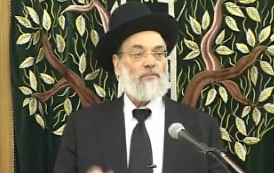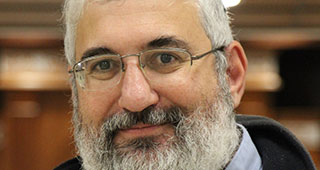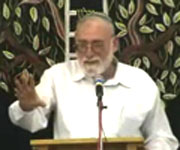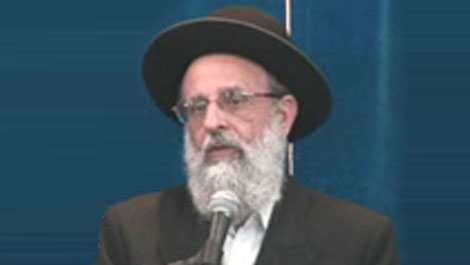Beit Midrash
- Shabbat and Holidays
- Jewish Holidays
- Sukkot
Question #2: "My aunt, who always takes the family out to eat when she visits, will be in town for Sukkos, and knows that her favorite restaurant has a sukkah for Chol Hamoed. Can we rely on the restaurant's sukkah?"
Answer: This article, which is a revised version of an interview I provided to Mishpacha magazine a few years ago, covers some of the more common halachic issues and problems one finds regarding Sukkos. Although I have edited the original article somewhat, I have left the interview structure. A pdf of the original article can be found on RabbiKaganoff.com
Mishpacha: Rav Kaganoff, I am very appreciative that you have been able to make time for us. Can you mention what types of halachic issues you have noticed concerning the validity of Sukkos?
RYK: The laws of sukkah are very complicated, and a rav should not assume that his members know how to construct a kosher sukkah, unless he himself has been certain to teach them thoroughly. If the rav has not (yet) taught them properly, then one can certainly assume that there will be many issues concerning the sukkah walls and the schach, and, potentially, questions even where they place the sukkah, since they may build it under trees or overhangs.
How frequent the problems occur will depend on how well a rav has succeeded in educating his membership to the basic requirements of sukkah. There are two obvious ways he can teach them. One is by mentioning aspects of the laws of sukkah whenever he has an opportunity during the weeks before Sukkos – a little bit before his drasha on Shabbos; a little after daily Shacharis and between Mincha and Maariv. Another method is to offer to make "sukkah calls," just like doctors used to make house calls! The message eventually gets through, and I noticed how, with time, my shul members became very sensitized to the main issues.
Mishpacha: Could you point out the most frequent problems you have found and explain why there are concerns?
RYK: Certainly. Let me first introduce the fundamentals of sukkah construction. A sukkah consists of two basic components, its walls and its roof, which we call the schach; and each has very specific halachic requirements. The schach must be of vegetative material that once grew from the earth but is no longer connected to the earth, is not food, and has not been fashioned in a way that halacha considers it a "vessel" or a "utensil."
The correct term for these items is that they are mekabeil tumah, susceptible to becoming tamei, should they be in contact with a tamei item. The exact rules defining what qualifies as a utensil are fairly complicated, and it is interesting how much halachic literature is devoted to defining whether such diverse items as arrow shafts, wooden ladders, thread, and straw or reed mats may be used as schach – meaning, are they processed enough to be considered "utensils" for halachic purposes or not. However, a full treatment of this topic is beyond the parameters of this article.
A "Venetian" Sukkah
There are many interesting discussions about the use of other common household items for schach. For example, in 1941 a rav asked Rav Moshe Feinstein whether one can use venetian blinds, at that time made of wood slats attached with cloth, as schach. The inquirer wanted to permit their use, since both the slats and the cloth are made from materials that grow from the ground. Rav Moshe demonstrates from the Talmudic sources that although the wood is basically unprocessed, once it has been attached to the cloth, it is halachically considered a utensil and may not be used as schach. 1
Walking (under) the Plank
There are also categories of items that the Torah permitted as kosher schach, but were later prohibited by the Sages because of various concerns. For example, wide wooden planks are not utensils and do meet all the other requirements for schach and, therefore, should be acceptable. However, the Sages prohibited using them out of concern that someone might mistakenly assume that his regular wood roof would be satisfactory as a cover for his sukkah. 2 Although today it is unusual to make a roof out of wood boards, in early generations these were standard roofing materials.
This developed into a halachic controversy not that long ago: May one use wooden slats or laths for schach? I remember seeing wooden slats used commonly as schach material by respected Torah scholars, whereas other, equally knowledgeable Torah scholars took strong exception to using this as schach, invalidating it because slats are used in construction. (Shu"t Yaskil Avdi Volume VI Orach Chayim #20 analyzes both sides of the question. He also quotes a very interesting reason why people prefer using slats to other types of schach. He contends that it is uncommon for them to be insect infested, whereas other forms of schach often have such a problem.)
Metal in the Schach
Many people assume that if one puts any metal into the schach, such as nailing together the schach, the sukkah cannot be used. This is not accurate, although they are correct that one should not use metal to assemble or support the schach, such as by resting the schach on a metal framework. However, the vast majority of halachic authorities conclude that if a sukkah was assembled in a way that its schach is held up by metal, the sukkah may be used. Let me explain.
Supporting the Schach – the Maamid
The Gemara discusses whether the schach must be "held up" -- supported by material that could be used for the schach itself. The majority opinion contends that the rules I mentioned above apply only to the schach and not to what supports the schach, which is called the maamid. 3 According to this opinion, one may use any material at all to support schach, and even having your schach rest directly on steel girders is perfectly fine. 4
There is a minority opinion that contends that the rules of schach material apply, also, to what supports the schach. Following this latter approach, one must be careful not to have the schach supported by metal or, for that matter, any other material that would not be kosher schach.
Usually the halacha follows the majority opinion, and following their view, as long as the schach itself is "kosher," we need not be concerned about what supports the schach. Indeed, most early authorities follow the majority opinion, concluding that there is no halachic problem with supporting the schach with material that would, itself, be invalid schach. 5 Thus, according to them, one could construct a metal framework, rest the schach on it and the sukkah is perfectly kosher. However, there are some early authorities who take the more stringent approach and conclude that one may not support the schach with material that is itself not kosher for schach. 6
The conclusion of the later halachic authorities is that although we follow the majority opinion and permit the use of a sukkah whose schach is supported by metal or other invalid-for-schach material, one should not construct a sukkah this way. In other words, one should try to construct a sukkah that is kosher according to all opinions, by supporting the schach with material that itself is valid for schach, but a sukkah constructed ignoring this concern is nevertheless kosher. 7
This has many ramifications. For example, you are invited to someone's house for a meal or Kiddush during Sukkos and discover that their schach is held up by metal or other material that is invalid as schach. Alternatively, you take the family to a recreational area on Chol Hamoed and discover that the sukkah there was erected with the schach held up by a metal frame. You may eat there and enjoy your meal, since the sukkah is kosher, notwithstanding that those in charge should not have assembled the sukkah this way.
The above section elicited the following subsequent inquiry: "It would seem that this halacha applies only regarding the beams that hold up the schach. Meaning, if the metal nails are making sure only that the schach doesn’t slip off the beams, metal may be used. However, if the schach would blow away with a ruach metzuyah, a typical wind, then nailing it down would be forbidden according to the opinion that you should not use metal or the like to hold up the schach."
Rabbi Kaganoff responds:
"My answer was somewhat ambiguous, and I thank you for bringing it to my attention.
To clarify the matter: the schach should be placed in a way that it is held up and held in place by items which are themselves kosher for schach. If the schach would fall through, or be blown off by a commonly occurring wind, one should not secure it with something that, itself, is not kosher schach. However, if the schach is sufficiently heavy that a common wind would not blow it out of place, but one wants to secure it better so that it does not slip or move, one may secure it even with metal or a different item that is, itself, not kosher schach."
"Threading" the Schach
I mentioned before that there are items that meet the Torah's requirements as kosher schach, but were later prohibited by the Sages because of various concerns: The Sages prohibited using combed flax as schach, even though it meets all the Torah requirements 8 -- it grows from the ground and is now disconnected, is not edible and is not a utensil. The early authorities debate why combed flax was banned for schach use, some contending that it was prohibited because it no longer appears like it grew from the ground, 9 whereas others prohibited its use because it is only one step away from spun flax which is mekabeil tumah, 10 as stated in the Torah, and is therefore invalid because of Torah law. 11
Does this dispute concerning why the Sages banned use of unspun flax have any halachic ramifications? Indeed it does, and this affects the kashrus of some varieties of schach mats. Is cotton or hemp thread kosher for schach use? This will depend on why combed but unspun flax was prohibited. If combed flax was prohibited because it no longer appears like it grew from the ground, then cotton or hemp thread or string would similarly be prohibited. On the other hand, if unspun flax was prohibited because someone may errantly use spun flax as schach, then there is no reason to invalidate the use of cotton, hemp or similar thread as schach. Now, it appears highly impractical that anyone would use thread as schach, but but the question whether thread can be used as schach impacts on whether thread can be used to tie together the schach, a topic that became an interesting issue with the development of "schach mats."
Mishpacha:
How so?
Schach Mats
Let me mention that I may have been the first rabbi ever to provide a hechsher to schach mats. Before that time, different companies were producing these mats, but none of them had a hechsher, although a few responsa had been written concerning whether these mats were valid schach.
There was a very interesting curiosity with the schach mats. The fellow who met me and asked me for a hechsher was manufacturing and selling prefab sukkahs, complete with the schach. He came to me with his planned design for the schach, and I suggested improvements on the design, so that there would be no halachic issues involved, which he followed. I then provided him with a letter of certification on the mats. At the time, the idea of a hechsher on schach mats was very original, and I received inquiries from many rabbonim.
Mishpacha:
What design changes did you make?
RYK:
His sukkah design called for large mats made from split pieces of bamboo tied together with string. Assuming that these were to be made in China, I had a halachic concern. In China, bamboo mats are used as mattresses, which might invalidate a mat made there, even if it was intended for transport and sale elsewhere. 12 To avoid this problem, I told him to have the factory weave every six inches a piece of bamboo too thick to lie upon comfortably. This way these mats could never be used for sleeping, even by the Chinese, and their status as kosher schach mats was uncompromised.
I also had him make another design correction. The sample had the mats tied together with nylon thread, which I did not want. The problem is that nylon does not grow from the ground, and it is therefore not kosher schach. Thus, the thread holding the mat together was not kosher schach, and this thread has the status of a maamid, that which "supports" the schach, since the mat would fall into the sukkah if it was not tied together.
There was another potential question about these mats, even if they were tied with cotton or hemp string. As I mentioned above, it appears to be dependent on a dispute among authorities whether these threads are valid for use as schach. If they are not valid, then they should not be used to be "maamid" the schach either, since we rule that one should build a sukkah in a way that it is kosher according to all opinions, including those who invalidate maamid that is not kosher for schach.
However, I permitted him to make the sukkah mats and tie them together with cotton thread. Since some authorities consider these strings to be valid schach, the ruling of the late authorities not to use invalid schach material to support the schach should only apply when the supporting material is certainly invalid. 13
There is a second reason to permit cotton string to tie the schach mat. Even if we assume that cotton string is invalid for schach, it is invalid only as a rabbinic stringency, and there are early sources who rule that even those who invalidate maamid that is not kosher schach do so only with schach that the Torah prohibited using, not with schach that was prohibited only as a rabbinic prohibition. To explain:
The halachic authorities cite two reasons to invalidate maamid that is not kosher as schach. Rashi states that using an invalid maamid is equivalent to using invalid schach. According to this approach, the Bach contends that the Torah, itself, invalidated maamid that is not kosher schach. On the other hand, Milchemes Hashem and Ran both state that the use of invalid maamid is only a rabbinic injunction to avoid people erring and using invalid schach. According to the latter approach, one could argue strongly that Chazal only prohibited use of a maamid that would be invalid schach min haTorah, but banning something invalid only miderabbanan would constitute a gezeirah legezeirah, a rabbinic injunction created to avoid violating another rabbinic injunction, something that Chazal are not empowered to do.
Slatted Mats
When the first commercially-produced schach mats reached the market in Israel, there was debate among the halachic authorities whether they could be used. These mats were made from thin pieces of wood tied together with nylon or cotton string. For a variety of reasons, the authorities disagreed on whether these mats could be used as schach. Some were concerned that tying wood pieces together might make the entire piece into one big board and invalidate its use as schach, just as the Sages prohibited use of wide boards, out of concern that someone might think that his regular house roof is valid for a sukkah. The majority of authorities were not concerned about this problem, but were very concerned about mats that used nylon strings to hold them together, considering the string as a maamid.
Some authorities were even concerned with the use of schach mats that used cotton or hemp thread or string to tie them together, being more concerned than I had been when I gave a hechsher to the schach mats. They felt that, ideally, one should not manufacture mats with cotton thread since, according to some opinions, this might constitute a maamid that is not valid schach. 14 Others felt that it was perfectly fine to use schach mats tied together with cotton thread. 15
By the way, some of today's schach mats are produced with a much rougher bamboo that could not possibly be used for roofing material, and they are then tied together with a rough natural twine that should avoid any concerns about the thread.
Must I Fumigate my Schach?
Mishpacha:
Talking about schach mats, there has been a large of discussion lately about the problem of insect infestation in schach mats, and people are being given very extensive instructions in how to fumigate their mats.
RYK:
There are some contemporary authorities who feel that people should check their schach carefully for insects, whether their schach is brand new or stored from last year. 16 One should note that the Aruch Laneir, in his addenda Tosafos Bikkurim to the end of Shulchan Aruch Orach Chayim Chapter 627, advises not to hang flowers from the schach for decorations, out of concern that the flowers are infested with small insects that, indeed, could fall unnoticed into one's food.
Others note that since most people spread beautiful white tablecloths on their tables during Sukkos, they would readily notice if insects had fallen from the schach onto the white cloth.
I will continue this article next week, with a discussion about the manufacture of the sukkah walls.
^ 1.Shu"t Igros Moshe, Orach Chayim 1:177
^ 2.Gemara Sukkah 14a
^ 3.Gemara Sukkah 21b
^ 4.See Gemara Sukkah 2a
^ 5.Few Rishonim (other than those mentioned in the next footnote) quote the issue of maamid, and Terumas Hadeshen (1:91) and Shulchan Aruch in Orach Chayim 630:13 clearly rule that maamid is not a concern.
^ 6.Milchemes Hashem and Ran, Sukkah 21b; Bach, Orach Chayim 629.
^ 7.Magen Avraham 629:9, whose position is accepted by the majority of later authorities.
^ 8.Gemara Sukkah 12b
^ 9.Rambam, Hilchos Sukkah 5:4
^ 10.Tosafos, Sukkah 12b s.v. Ba'anitzei. There are other opinions to explain this Gemara, but they will not affect the halacha that we are discussing.
^ 11.Linen thread, which is the same thing as spun flax, will become tamei if tzaraas appears on it, see Vayikra 13:48, and is therefore invalid schach since this qualifies it as a davar hamekabeil tumah.
^ 12.See Gemara Sukkah 19b and the Rosh ad loc.
a class="footnote" name="13b" href="#13a">^ 13.
^ 14.Shu"t Shevet Halevi 6:74; Shu"t Yeshuas Moshe 3:52
^ 15.Shu"t Yechaveh Daas 1:64
^ 16.Bedikas Hamazon Kahalacha by Rabbi Moshe Vaya, Volume III pages 784-786
This Shiur is published also at Rabbi Kaganof's site
Filling the Vacuum – Literally
Rabbi Yehuda Zoldan | 14 Tishrei 5784

Dwelling in God's Palace
Rabbi Avraham Yitzchak HaLevi Kilav | 5764
The Four Species of Sukkot - Victory!
Rabbi Yosef Nave | 14 Tishrei 5784
























